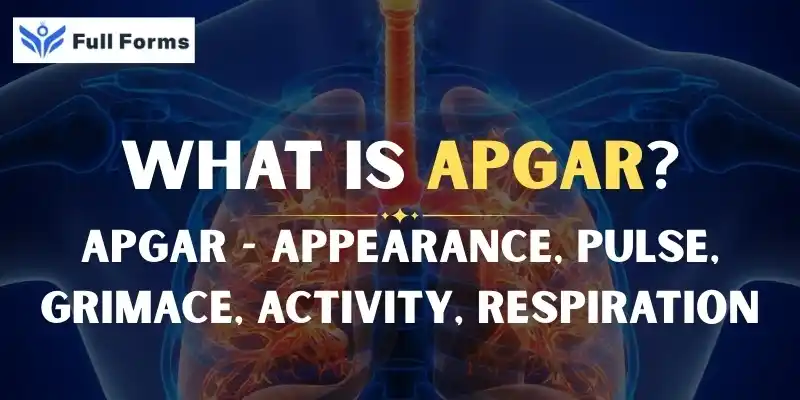Appearance, Pulse, Grimace, Activity, Respiration
(APGAR)

Description
APGAR Scoring Overview
The baby was just given scores based on his skin Appearance, Pulse, Grimace, Activity, and Respiration. Sort of test that physicians and nurses quickly run after a baby is born. From what I understand, it allows them to quickly determine how healthy the baby is and how well the baby is adjusting to life outside the womb.
What is APGAR?
Physicians check for important signs using the acronym APGAR: Appearance, Pulse, Grimace, Activity, and Respiration. Let’s find out what each of these is and why they are so important for the health of a newborn.
APGAR Scoring:
A way to examine the infants’ health conditions immediately for the neonatologists and nurses a simple method is APGAR scoring which was developed by Dr. Virginia Apgar in 1952.
The sum of all scores can range between 0 and 10, with each sign having a value of 0, 1, or 2.
APGAR in Five: Appearance
You look at the baby’s skin color to see if it is getting enough air.
- 0: Your baby’s whole body is blue or very pale.
- 1: Pink body but blue hands and feet because of acrocyanosis
- 2: The pink color of the whole body of the baby indicates good flow of blood.
Pulse or Heart Rate
It’s just a test for a baby’s heart rate.
- 0: No heartbeats detected
- 1: Heart rate is under 100 bpm - it’s low
- 2: Heart rate more than 100 bpm - fine and healthy
Grimace or Reflex Response
Presenting how the baby responds to such irritating factors, for example, slight pinching or suction.
- 0: No response.
- 1: Grimace/weak response.
- 2: Strong reaction/Crying.
Muscle Tone Activity
Observation regarding total movement of the baby and the strength of the muscles.
- 0: Flaccid limbs
- 1: Some flexion or resistance in the arms and legs
Fine movements
- 0: The baby is not moving their arms and legs at all.
- 1: The baby is flexing their arms and legs, and moving around a little.
- 2: The baby is moving their arms and legs around a lot.
Breathing (Respiration)
It assesses the efficiency of the infant’s breathing.
- 0: Absent
- 1: Weak or irregular
- 2: Strong : regular
APGAR score interpretation?
Most of the time a score between 7 and 10 is normal. That’s the baby’s healthy range so he usually doesn’t need extra medicine or medical help.
On the other hand, a score of 4-6 could mean that the baby requires intervention to do with, for example, breathing, keeping warm.
If the score is less than 4 then this means the baby needs critical medical attention right there, such as oxygen or other resuscitation.
The APGAR score can’t predict whether or not a baby will have problems in the future; it just helps health care providers to take care of the baby in those first several minutes of life.
Why is the APGAR Score Important?
Those first minutes after a baby is born are very critical. A baby has to quickly start breathing on its own. It can’t rely on the placenta of his or her mother for oxygen.
Observational appearance, heart rate, reflex irritability, muscle activity, and respiration shortly constitute the complete sufficient manpower examination at anybody’s disposal to gauge the condition of a baby. They can respond immediately; otherwise, they do not have to take their time. ‘‘And it gives parents the feeling of being in the know about their newborn.’’
Low APGAR Score: What Does This Mean?
In case the infant’s APGAR score appears low, attending doctors or nurses can supplement the baby with extra oxygen and/or breathing support, e.g., by mask or ventilator.
- Keeping the body warm helps to keep it at the right temperature
- Clearing airways or from sucking fluids out
- Other emergency measures depending on need
Most infants do well with quick care and attain better scores post 5 minute examination.
How it looks
| Category | Score 0 | Score 1 | Score 2 |
|---|---|---|---|
| Color | Blue or light all over | Pink body, blue hands and feet | All pink |
| Pulse | No heartbeat | Less than 100 beats per minute | More than 100 beats per minute |
| Face Reaction | No Reaction | Weak grimace or feeble response | Loud Cry or reactive response |
| Activity | Lethargic | Minimal restricted motion | Weak flexion, stirring about |
| Breath | Absent | Inert or erratic; feeble | Crying vigorous |
Final Comments
It is very good to have a look at checking the baby’s health right after birth. It helps a lot in giving health providers the information they need to start life with shortly transcribed.
If you are pregnant, or know someone who is, you need to come to understand what the APGAR score is all about so as to ascertain how well babies are being taken care of to ensure they start life health and strong.
